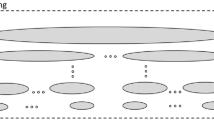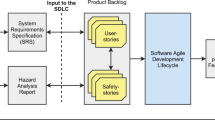Abstract
Contemporary service enterprises face challenges of the rapidly evolving technologies and business environments. Thus, the precise analysis and the accurate planning can be a key to the selection of the “right” strategies for IT investments and the implementation of any new technologies. Consequently, the purpose of this paper is to contribute to the profiling and development a “Fail-safe” (i.e., Consistent) Service-oriented formal model to support architectural decisions in service enterprise planning, and dynamic business activities managing by “Fault-tolerant” design. Furthermore, the objective is to construct a “process/formal model” that can be applied by services providers in assignments concerning enterprise architecture, or IT architecture, planning and development. And, in turn, the goal of the “process/formal model” is to cover both areas of activity: the planning and enterprise processes effective management and development with a dependable (i.e., “Fault-tolerant”) methodology to save time and resources along the life-cycle.
Similar content being viewed by others
References
AbouRizk SM, Mandalapu SR, & Skibniewski M (1994) Analysis and evaluation of alternative technologies. Journal of Management in Engineering:65–71.
Acharya M et al. (2005) SOA in the Real World-Experiences. LNCS-3826:437–449.
Andrews KR (1994) The Concept of Corporate Strategy. 3rd ed., McGraw Hill/Irwin.
Armour FJ, Kaisler SH (2001) Enterprise Architecture: Agile Transition and Implementation. IEEE IT Pro:30–37.
Ashton H, Kelly D (2006) The Business Impact of BPM with SOA: Building a Business Case for BPM with SOA ROI. Upside Research, Newton, MA.
Auer L, Belov E, Kryvinska N, & Strauss C (2011) Exploratory Case Study Research on SOA Investment Decision Processes in Austria. CAiSE-2011, London, UK, Springer LNCS-6741.
Aziz S, Obitz T (2007) Enterprise Architecture is Maturing. Infosys Enterprise Architecture Survey, Infosys Technologies.
Bacon CJ (1992) The use of decision criteria in selecting information systems/technology investments. MIS Quarterly:335–353.
Barua A, Kriebel CH, & Mukhopadhyay T (1995) Information technologies and business value: an analytic and empirical investigation. Information Systems Research 6(1):3–23.
Bearing Point White Paper (2005) Business Systems Integration Charting the Path to Enterprise Agility. Bearing Point Institute for Executive Insight.
Bernus P, Nemes L, & Schmidt G (2003) Handbook on Enterprise Architecture. Berlin-Heidelberg: Springer-Verlag.
Boehm B (1988) A Spiral Model of Software Development and Enhancement. Computer: 61–72.
Boehm B et al. (1997) Developing Multimedia Applications with the WinWin Spiral Model. Proceedings, ESEC/FSE 97, Springer.
Boggs R (2007) Business Agility as Growth Enabler: How Can Midsize Firms Manage Change in an Increasingly Demanding World? Sponsored by SAP, #208377 IDC White Paper. BPMI, Business Process Management Initiative. http://www.bpmi.org. Accessed 2012-04-23.
Brezany P, Hofer J, Wohrer A, & Tjoa A M (2003) Towards an open service architecture for data mining on the grid. Proceedings of the 14th International Workshop on Database and Expert Systems Applications, Prague, Czech Republic:524–528.
Brown PC (2007) Succeeding with SOA: Realizing Business Value Through Total Architecture. Addison-Wesley.
Davenport TH, Short JE (1990) The New Industrial Engineering: Information Technology and Business Process Redesign. Sloan Management Review, Summer:11–27.
Davenport TH (1993) Process Innovation: Reengineering Work through Information Technology. Harvard Business School Press: Boston, MA.
Demydov I, Kryvinska N, & Klymash M (2009) An Approach to the Flexible Information/Service Workflow Managing in Distributed Networked Architectures. Proceedings of the International Workshop on Design, Optimization and Management of Heterogeneous Networked Systems (DOM-HetNetS’ 09), in conjunction with the 38th International Conference on Parallel Processing (ICPP-2009), September 22nd–25th, Vienna, Austria: 236–242.
Ellmer E, Merkl D, Quirchmayr G, & Tjoa A M (1996) Process model reuse to promote organizational learning in software development. Proceedings of 20th International Computer Software and Applications Conference (COMPSAC’96), Seoul, Korea:21–26.
Engelhardt-Nowitzki C, Kryvinska N, & Strauss C (2011) Strategic demands on information services in complex, uncertain build-to-order businesses-A layer-based framework from a value network perspective. 1st Int. Workshop on Frontiers in Service Transformations and Innovations (FSTI-2011), in conjunction with EIDWT 2011, Tirana, Albania. Gartner leader’s toolkit (2007) Justifying Service-Oriented Architecture Initiatives. Gartner.
Greenbaum J (2005) Return on Investment for Composite Applications and Service Oriented Architectures: A Model for Financial Success and Enterprise Efficiency. Enterprise Applications Consulting, Fall.
Haberer K (2003) Building World-Class Finance and Performance Management Capabilities: The ROI of Performance Management. White Paper, CFO Project 2.
Haeckel S (1999) Adaptive Enterprise: Creating and Leading Sense-and-Respond Organizations. Harvard Business School Press, Cambridge, MA.
Henbury C (2000) Agile Enterprise Strategy. Created by Paul T. Kidd, Revised.
Iacob M-E, Jonkers H (2006) Quantitative Analysis of Enterprise Architectures. book chapter, in book: Interoperability of Enterprise Software and Applications, Springer London.
Iansiti M, Favaloro G (2006) Enterprise IT capabilities and Business Performance, Keystone Strategy Inc.
Jeng J-J (2006) Service-Oriented Business Performance Management for Real-Time Enterprise. Proceedings of the 8th IEEE International Conference on E-Commerce Technology and the 3rd IEEE International Conference on Enterprise Computing, E-Commerce, and E-Services (CEC/EEE).
Josefowicz M (2003) Business/IT alignment is a critical success factor for insurers. Celent’s report, Celent’s Insurance Group, New York, NY, USA.
Khoshafian S (2007) Service Oriented Enterprises. Auerbach Publications Taylor and Francis Group, LLC.
King WR (1995) Creating a Strategic Capabilities Architecture. Information Systems Management, 12(1):67–69.
Kryvinska N, Strauss C, Auer L, & Zinterhof P (2008a) Conceptual Framework for Services Creation/Development Environment in Telecom Domain. Proceedings of the 10th International Conference on Information Integration and Web-based Applications and Services (iiWAS2008), in cooperation with ACM SIGWEB, Austria:324–331.
Kryvinska N, Auer L, & Strauss C (2008b) Managing an Increased Service Heterogeneity in Converged Enterprise Infrastructure with SOA. Inderscience Publishers, International Journal of Web and Grid Services (IJWGS) 4(4).
Kryvinska N, Auer L, & Strauss C (2009) The Place and Value of SOA in Building 2.0-Generation Enterprise Unified vs. Ubiquitous Communication and Collaboration Platform. Proceedings of the Third IEEE International Conference on Mobile Ubiquitous Computing, Systems, Services and Technologies (UBICOMM 2009), Sliema, Malta: 305–310.
Kryvinska N (2010) Converged Network Service Architecture: A Platform for Integrated Services Delivery and Interworking. Book, Electronic Business series, International Academic Publishers, Peter Lang Publishing Group, 2.
Kryvinska N, Auer L, & Strauss C (2011) An Approach to Extract the Business Value from SOA Services. Second International Conference on Exploring Services Science (IESS 1.1), Springer LNBIP-82, Geneva, Switzerland.
Lee I (2004) Evaluating business process-integrated information technology investment. Emerald Group Publishing, Business Process Management Journal 10(2):214–233.
Leinbach C (2000) E-Business and Spiral Development. Proceedings USC-SEI Spiral Experience Workshop.
Linthicum DS (2004) 12 Steps to Implementing a Service Oriented Architecture. Grand Central Communications.
List B, Schiefer J, Tjoa A M, & Quirchmayr G (2002) Multidimensional Business Process Analysis with the Process Warehouse. In W. Abramowicz and J. Zurada (Eds.): Knowledge Discovery for Business Information Systems, Chapter 9, The International Series in Engineering and Computer Science, Springer.
McKendrick J (2007) BI, BPM, and SOA in Action, Together. July 9th. http://www.soainaction.com/blog/2007/07/bi_bpm_and_soa_in_action_toget.php. Accessed 2012-04-21.
Melnicoff RM, Goyal DK, & Curtis GA (2007) SOA: Tailwind for IT investments. The journal of high-performance business-Outlook-published by Accenture.
Nigam A, Caswell N S (2003) Business artifacts: An approach to operational specification. IBM Systems Journal 42(3):428–445.
OASIS Standard (2006) Reference Model for Service Oriented Architecture 1.0. OASIS.
Obitz T, Doddavula SK, & Aziz S (2007) Enterprise Architecture Survey 2007, Executive Summary. Infosys Technologies.
Osterfelt S (2002) Take the Plunge. DM Review Magazine.
Perks C, Beveridge T (2003) Guide to Enterprise IT Architecture. Springer.
Pernul G, Tjoa A M, & Winiwarter W (1998) Modelling Data Secrecy and Integrity. Data and Knowledge Engineering 26(3).
Prahalad CK, Hamel G (1990) The Core Competence of the Corporation. Harvard Business Review.
Pulkkinen M (2006) Systemic Management of Architectural Decisions in Enterprise Architecture Planning. Four Dimensions and Three Abstraction Levels. In proceedings of the 39th Hawaii IEEE International Conference on System Sciences.
Reijers HA (2006) Implementing BPM systems: the role of process orientation. Emerald Group Publishing, Business Process Management Journal 12(4):389–409.
Ross JW, Weill P, & Robertson DC (2006) Enterprise architecture as strategy: creating a foundation for business execution. Harvard Business School Press.
Saha P (2007) Handbook of Enterprise Systems Architecture in Practice Information Science Reference. IGI Global, ISBN 978-1-59904-189-6.
Schekkerman J (2003) How to Survive in the Jungle of Enterprise Architecture Frameworks. Trafford Publishing, North Carolina.
Schniederjans MJ, Hamaker JL, & Schniederjans AM (2004) Information Technology Investment-Decision-Making Methodology. World Scientific Publishing Co. Pte. Ltd.
Shank JK, Govindarajan V (1992) Strategic cost analysis of technological investments. Sloan Management Review, Fall:39–51.
Silver B (2002) Three Promises of BPM: Agility, Flexibility, Visibility. Transform Magazine.
Sinur J, McCoy DW, & Thompson J (2003) SOA and BPM Form a Potent Combination. Gartner ID Number:T-19-4751.
TOGAF (2002) The Open Group: The Open Group Architecture Framework (TOGAF), Version 7 Technical Edition, and Version 8 Enterprise Edition. Doc. Nr. 1911.
TOGAF (2007) The Open Group: The Open Group Architecture Framework (TOGAF), Version 8.1.1 Enterprise Edition. Doc. Nr G063s, ISBN:1-931624-62-3.
Veasey PW (2001) Use of Enterprise architectures in managing strategic change. MCB University Press, Business Process Management Journal 7(5):420–436.
Ventana Research (2003) The Value of Enterprise Planning, Immediate Positive Impact for the Entire Organization. White Paper.
Veryard R (2007) Business Best Practice Report: Towards the Agile Business Process. Everware-CBDI Inc., CBDI journal.
Wegmann A (2003) On the Systemic Enterprise Architecture Methodology (SEAM). In Camp, O et al. (eds.) Proceedings of the International Conference on Enterprise Information Systems (ICEIS 2003), Angers, France.
Whitman L, Ramachandran K, & Ketkar V (2001) A Taxonomy of a Living Model of the Enterprise. Proceedings of the 2001 Winter Simulation Conference, IEEE:848–855.
Woolf B (2008) Exploring IBM SOA Technology and Practice-How to Plan, Build and Manage a Service Oriented Architecture in the Real World. Maximum Press.
Senor J (2005) Service-Oriented Architecture-A New Alternative to Traditional Technology Integration. White Paper, iWay Software.
Author information
Authors and Affiliations
Corresponding author
Additional information
Natalia Kryvinska is a Postdoctoral Fellow at the e-Business research group, Faculty of Business, Economics and Statistics, University of Vienna. She received her diploma engineer degree in telecommunications from National University “Lviv Polytechnics”, Lviv, Ukraine, and a PhD in electrical engineering from the Vienna University of Technology, Vienna, Austria. Her research interests include distributed systems management, service delivery platforms, and e-Services.
Rights and permissions
About this article
Cite this article
Kryvinska, N. Building consistent formal specification for the service enterprise agility foundation. J Serv Sci Res 4, 235–269 (2012). https://doi.org/10.1007/s12927-012-0010-5
Received:
Accepted:
Published:
Issue Date:
DOI: https://doi.org/10.1007/s12927-012-0010-5




